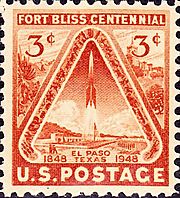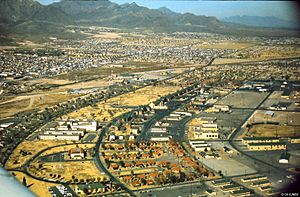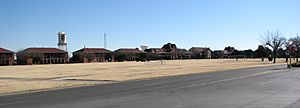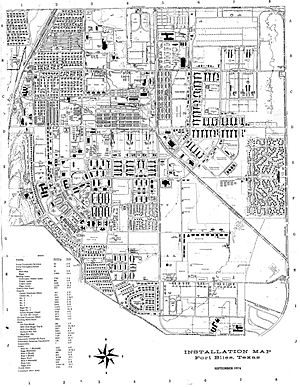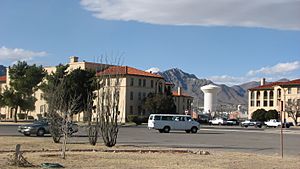Fort Bliss facts for kids
Quick facts for kids Fort Bliss |
|
|---|---|
| Part of Army Forces Command (FORSCOM) | |
| El Paso County, Texas and Doña Ana / Otero counties, New Mexico, Southwestern United States | |

A 1-37AR, 1st Armored Division Abrams tank crew on Fort Bliss' Orogrande Range Camp in 2019.
|
|
|
Location of Fort Bliss
|
|
| Coordinates | 31°48′07″N 106°25′29″W / 31.801847°N 106.424608°W |
| Type | Military base |
| Site information | |
| Controlled by | |
| Facilities | Biggs Army Airfield McGregor Range |
| Site history | |
| Built | 1849–1893 |
| In use | 1849–present |
| Garrison information | |
| Current commander |
MG James P. Isenhower III |
| Past commanders |
John J. Pershing |
| Garrison |
5th Armored Brigade 86th Expeditionary Signal Battalion |
| Occupants | DCG:
|
Fort Bliss is a large United States Army base located in New Mexico and Texas. Its main office is in El Paso, Texas. The base is named after LTC William Bliss, a math professor who was related to President Zachary Taylor.
Fort Bliss covers about 1,700 square miles (4,400 km²). It is the biggest base in the United States Army Forces Command (FORSCOM). It's also the second largest Army base overall. The largest is the nearby White Sands Missile Range.
A part of Fort Bliss in El Paso County, Texas, is a special area with 8,591 people living there (as of 2010). Fort Bliss has the largest open airspace in the Continental United States. This space is used for training and testing missiles and artillery. It also has the biggest area for military movements, covering 992,000 acres. The entire base covers 1.12 million acres. It reaches to the Lincoln National Forest and White Sands Missile Range in New Mexico. Fort Bliss also includes the Castner Range National Monument.
Contents
- Army Units at Fort Bliss
- 1st Armored Division: What They Do
- More Units and Agencies
- Base Facilities
- Fort Bliss History
- What Fort Bliss Does Today
- Local Impact
- Geography
- Demographics
- Education
- Museums and History
- See also
Army Units at Fort Bliss
Fort Bliss is home to the 1st Armored Division. This division came back to the U.S. in 2011 after 40 years in Germany. The 1st Armored Division Sustainment Brigade supports this division.
The base also hosts Joint Task Force North (JTF-N). This group helps federal law enforcement agencies. They work to stop crime groups and protect the country. JTF-N also helps train military units.
The 32nd Army Air and Missile Defense Command (AAMDC) is another important unit. It plans and carries out air and missile defense missions worldwide. They can deploy their forces within 72 hours.
The Joint Modernization Command (JMC) is also here. It plans and tests new ways for the Army to fight. JMC helps the Army make decisions about new technologies.
1st Armored Division: What They Do
The 1st Armored Division has several important teams:
- 1st Brigade Combat Team ("Ready First"): This team is ready to go anywhere. They conduct land operations to support larger military groups. They train to fight enemies and control land.
- 2nd Brigade Combat Team ("Strike"): Like the "Ready First" team, they are prepared to deploy. They conduct similar land operations. Their goal is to stop enemy forces and protect U.S. interests.
- 3rd Brigade Combat Team ("Bulldog"): This team also prepares for quick deployment. They perform decisive land operations. They are trained to disrupt enemy forces and secure areas.
- 1st Armored Division Combat Aviation Brigade ("Iron Eagles"): This group handles all aviation operations. They support commanders in land operations.
- 1st Armored Division Artillery ("Iron Steel"): They provide fire support for the 1st Armored Division. They help train other teams in using their fire support systems.
- 1st Armored Division Sustainment ("Muleskinners"): This team manages supply and support operations. They make sure the 1st Armored Division has everything it needs. They can quickly deploy to provide support in different areas.
More Units and Agencies
- The NCO Leadership Center of Excellence (NCOL CoE): This is a school for noncommissioned officers (NCOs). It provides military education to U.S. and allied NCOs.
- The United States Army Sergeants Major Academy (USASMA): This academy became a part of the Command and General Staff College in 2018. Students here can earn a Bachelor of Arts degree.
- The 11th Air Defense Artillery Brigade ("Imperial" Brigade): This brigade deploys units globally. They conduct air and missile defense operations. They protect important areas for military commanders.
- William Beaumont Army Medical Center (WBAMC): This is a hospital that serves military personnel and their families.
- The 5th Armored Brigade: This brigade helps train and prepare Army National Guard and Army Reserve units. They make sure these units are ready for missions around the world.
- The Fort Bliss Mobilization Brigade: This group handles all the paperwork and supplies for units getting ready to deploy or return home.
- The CONUS Replacement Center (CRC): The CRC prepares military personnel, DoD civilians, and contractors. They get them ready for deployment to overseas missions.
- The Army Field Support Battalion (AFSBn): This battalion helps keep military units ready. They make sure supplies are delivered to units at the base and in the field.
- The Network Enterprise Command: This unit protects the Army's computer networks. They provide important IT services to military customers.
- The Civilian Personnel Advisory Center (CPAC) -- Desert Mountain: CPAC helps hire and support the civilian workers at the base.
Fort Bliss also hosts the El Paso Intelligence Center (EPIC). This is a federal center that gathers information. Its military partner, Joint Task Force North, is at Biggs Army Airfield. Biggs Field is a military airport at Fort Bliss. It is used for sending out military forces.
The Fort Bliss National Cemetery is located on the base.
Base Facilities
- It is the second largest Department of Defense (DoD) base. It covers 1.12 million acres. It is next to the largest, White Sands Missile Range.
- It has over 924,000 acres for military movements.
- It has the only Digital Air Ground Integration Range (DAGIR) built to full Army standards.
- It has the longest runway in the Army. It is the 8th longest in the DoD.
- It has a major trauma center and a new medical center (WBAMC).
- It has one of the largest solar residential communities in the U.S. with over 4,000 homes.
- It has 2,139 buildings, covering over 24 million square feet.
Fort Bliss History
Early Locations (1849–1893)
First Post (1849–1854)
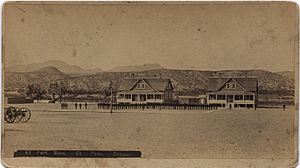
In 1846, Colonel Alexander William Doniphan led soldiers through El Paso del Norte. They won battles like the Battle of El Brazito. In 1848, the War Department ordered a post to be built across from El Paso del Norte.
On September 8, 1849, soldiers from the 3rd U.S. Infantry arrived. They found only a few small towns. The first post, called Post Opposite El Paso del Norte, was set up at Coon's Ranch. This area is now downtown El Paso, Texas. This post helped protect new U.S. territory from Apache and Comanche tribes. It also kept law and order and guided people going to the California Gold Rush.
Because of constant raids, soldiers had to move often. In September 1851, the Post Opposite El Paso was closed. Soldiers moved 40 miles (64 km) north to Fort Fillmore.
Becoming Fort Bliss (1854–1868)
On January 11, 1854, soldiers from the 8th Infantry set up the Post of El Paso at Magoffinsville. This was ordered by Secretary of War Jefferson Davis. The post was renamed Fort Bliss on March 8, 1854. It stayed there for 14 years. It was a base for troops protecting against Apache attacks.
During the American Civil War, the Confederate Army took control of Fort Bliss in 1861. They used it to launch attacks into New Mexico and Arizona. But after the Battle of Glorieta Pass, Confederate soldiers had to leave. Federal troops from California took over Fort Bliss in 1862. They kept a small force there until 1865. Then, other U.S. Army units, including Buffalo Soldiers, arrived.
Camp Concordia (1868–1876)
In 1867, the Rio Grande river flooded and damaged the Magoffinsville post. So, Fort Bliss moved to a new site called Camp Concordia in March 1868. This camp was south of where Interstate 10 is today. On March 11, 1869, the name Fort Bliss was used again.
Life at Camp Concordia was hard. The buildings were made of adobe. There was little water, heating, or proper sanitation. Soldiers often got sick from diseases like dysentery and malaria. Supplies arrived slowly by wagon train on the Santa Fe Trail. The Concordia post was left empty in January 1877. El Paso had no soldiers for over a year.
Hart's Mill (1878–1893)
On January 1, 1878, Fort Bliss became a permanent base. Soldiers from the Ninth Cavalry (Buffalo Soldiers) and the 15th Infantry were sent there. They helped stop conflicts over salt beds and water from the Rio Grande.
The government bought 135 acres (0.55 km²) at Hart's Mill. This was on the river's edge, near what is now the UTEP. New buildings were constructed. In 1881, the first railroad arrived. This helped solve supply problems for the fort and the growing town of El Paso. By 1890, Hart's Mill was no longer suitable. Congress approved $150,000 to build a new base. Local residents raised money to buy the land. They knew the base would help the local economy.
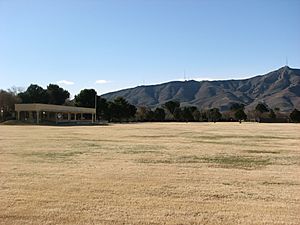
Present Site (1893-Today)
The current location of Fort Bliss is on La Noria mesa. Captain John Ruhlen designed it from 1891 to 1892. The first soldiers moved in during October 1893.
The Pershing Expedition
In January 1914, John J. Pershing arrived at Fort Bliss. He took command of the Army's 8th Brigade. This brigade was tasked with protecting the Mexico–United States border during the Mexican Revolution. In 1915, Pershing led the 8th Brigade into Mexico. This was called the Punitive Expedition. They were looking for the outlaw Pancho Villa, but did not find him.
On March 11, 2016, soldiers from Fort Bliss visited Pancho Villa State Park in New Mexico. This was the site of a raid by Pancho Villa's forces 100 years earlier. The soldiers learned about the history and took part in a parade.
World War I and World War II
During World War I, John J. Pershing became the commander of the American Expeditionary Forces (AEF). He was in charge of organizing and training a large, new army.
Fort Bliss was mainly a cavalry (horse-mounted soldiers) post until 1912. In 1928, it received its first armored cars and trucks.
During World War II, Fort Bliss focused on training soldiers for anti-aircraft artillery. In 1940, an anti-aircraft training center was set up. In 1944, the Anti-Aircraft Artillery School moved to Fort Bliss. This made it easier to train anti-aircraft gunners.

After World War II, in 1946, over 100 German scientists arrived at Fort Bliss. They were part of Operation Paperclip. Their job was to develop rockets. They helped with V-2 rocket tests at White Sands Proving Grounds. German families started arriving in 1946. By 1948, there were 127 German rocket specialists in the U.S.
The Cold War
Fort Bliss trained many U.S. soldiers during the Cold War. As the U.S. learned more about missiles, Fort Bliss and White Sands Missile Range became very important. They were expanded to support this work. On July 1, 1957, the U.S. Army Air Defense Center was created at Fort Bliss.
From 1957, Fort Bliss began using new missiles like Nike Ajax and Hawk. Fort Bliss became important for allowing troops to practice firing these missiles.
The base saw a lot of construction in 1954 and 1958. This was to build more housing, classrooms, and labs for missile training. The McGregor Range was also expanded for live missile firing. Fort Bliss remained a top place for testing anti-aircraft equipment during the Cold War.
Fort Bliss was also used for Ranger School training. This prepared soldiers for operations in desert areas. From 1983 to 1995, a Ranger training unit was based here.
Until 1990, Fort Bliss was used for Basic Training and Advanced Individual Training (AIT). This means soldiers learned their basic skills and then specialized skills here.
Base Changes in the 1990s
In 1995, the Department of Defense suggested moving some units from Fort Bliss. This left the base without any armored vehicles for a while. However, units that use the MIM-104 Patriot Missile Defense System moved to Fort Bliss in the 1990s. The Patriot system was very important in the Persian Gulf War in 1991.
The War on Terror
After the September 11, 2001 attacks, Fort Bliss sent anti-aircraft battalions to Afghanistan and Iraq. It also became a major center for deploying troops to these countries. This was done through Biggs Army Airfield. Fort Bliss also trained Afghan security forces at the United States Army Sergeants Major Academy. The goal was for these forces to take control of their own country's security.
Base Realignment and Closure, 2005
In 2005, the Pentagon decided to make Fort Bliss a major training base for heavy armor. About 11,500 new troops from the U.S. 1st Armored Division (who were in Germany) were moved here. Units from Fort Sill and Fort Hood also moved. This brought the total number of troops at Fort Bliss to 33,500 by 2012.
Officials in El Paso were very happy about this decision. It was expected to create about 20,196 new jobs in El Paso. This was the largest job gain in the U.S. from these base changes.
However, the Base Realignment and Closing Commission decided to move the Air Defense Artillery School and its Patriot missile systems to Fort Sill. Fort Bliss officials tried to keep the school, but the decision stood. About 4,500 soldiers were moved to Fort Sill, Oklahoma. All these troop transfers were completed by September 15, 2011.
On June 25, 2009, control of Fort Bliss moved from the United States Army Training and Doctrine Command to Forces Command.
What Fort Bliss Does Today
Fort Bliss has many important missions:
- It is home to the 1st Armored Division, one of the Army's main divisions.
- It is the largest base for preparing and sending out military forces in the DoD.
- It is one of the Army's biggest bases for projecting power.
- It is home to the Army's only CONUS Replacement Center (CRC).
- It works with other agencies like the El Paso Intelligence Center (EPIC) and Joint Task Force North (JTF-N).
- The Joint Modernization Command (JMC) tests new military ideas here.
- Soldiers can fire almost any weapon here, from pistols to missiles.
- It provides anti-aircraft and missile defense training.
- It hosts joint military exercises with U.S. and foreign units.
- It is a major base for maintaining and supplying military equipment.
- It is a top base for testing tanks and other vehicles.
- It stores thousands of military vehicles, including Patriot missile equipment.
- It hosted the USAADCEN Air Defense Artillery Center from 1942 to 2010.
- It monitors missile launches from White Sands Missile Range, 70 miles (113 km) north.
- It hosts the CONUS Replacement Center (CRC). This center trains soldiers, sailors, and airmen who are deploying individually.
- A special airfield for drones is being built north of the main base. It will host MQ-1C Gray Eagles for the First Armored Division.
Training missions are supported by the McGregor Range Complex in New Mexico. Most of Fort Bliss is actually in New Mexico. The main facilities are in El Paso, Texas.
Fort Bliss K-12 Schools
Bliss Elementary
Logan Elementary
Milam Elementary
Colin Powell Elementary
Chapin High
Separate from the main base are the William Beaumont Army Medical Center and a Department of Veterans Affairs center. These serve military and retired military personnel. A new medical center is planned to be finished in September 2019.
The base is also close to the El Paso Airport, Highway 54, and Interstate 10. There is a replica of the old Fort Bliss at Magoffinsville on the base. Other interesting places include the Buffalo Soldier memorial statue and a missile museum.
The old Fort Bliss Officers Club has adobe bricks that are over 100 years old. It now houses a Family Readiness Group. The Fort Bliss Welcome Center is nearby for new arrivals.
The area around Fort Bliss is a "No Drone Zone" enforced by the Military Police.
Local Impact
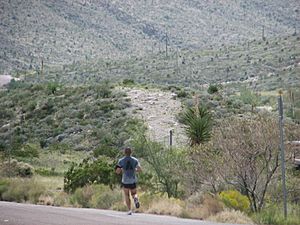
Fort Bliss is the biggest employer in the area. It supports over 167,000 people. It adds about $25.6 billion to the economy each year.
Fort Bliss is located near a population of more than 2.5 million people.
Fort Bliss has helped El Paso during local disasters. In 1897 and 1925, the fort provided food and shelter during floods. In 2006, soldiers and helicopters helped with rescue efforts during floods.
Fort Bliss is working to become a "net zero" energy base. This means it will produce as much energy as it uses. In 2013, a $120 million project was announced to build the largest solar farm in the U.S. military.
A study by Fort Bliss and El Paso found that removing salt from water (desalination) could increase El Paso's water supply by 25%. The Kay Bailey Hutchison Desalination Plant is on Fort Bliss property. It cleans groundwater for El Paso and Fort Bliss. This plant is the largest non-seawater desalination plant in the world.
In 2010, Fort Bliss became an "open post." This meant anyone with a valid driver's license could enter. However, as of 2015, Fort Bliss is no longer an open post.
In 2020, a Fort Bliss officer created a COVID-19 model. This model was used by the COVID-19 task force for El Paso.
Fort Bliss archaeologists manage 20,000 historical sites on the base. They also work with seven Native American tribes. The Hueco Tanks historic site is next to the base.
Geography
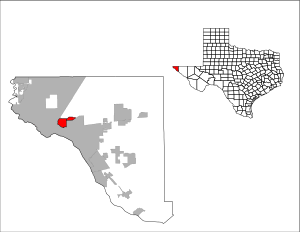
The Fort Bliss census-designated place is located at 31°48′07″N 106°25′29″W / 31.801847°N 106.424608°W. It covers 6.2 square miles (16.0 km²) of land. It is part of the Basin and Range Province.
Bunker 11507
In 2013, an investigation started into old dirt-covered bunkers on the base. These bunkers were used by the Air Force during the Cold War to store nuclear weapons. Low levels of radiation were found in Bunker 11057. The area around the bunker was closed on July 11, 2013.
Demographics

As of 2020, there were 11,260 people living on the base. The population density was about 628 people per square mile (242.59/km2).
The people living there were: 58.2% White, 16.5% African American, 2.4% Asian, 1.4% Native American, 0.5% Pacific Islander, and 15.9% from two or more races. About 23.5% of the population was Hispanic or Latino.
About 12.4% of the people were under 5 years old. 33.8% were under 18. Only 0.1% were over 65. About 38.2% of the population were women. The average household had 3.82 people.
The average income for a household on the base was $57,283. The income per person was $22,181. About 13.1% of the people were living below the poverty line.
Education
Fort Bliss is part of the El Paso Independent School District.
Bliss Elementary School and Milam Elementary School are on Fort Bliss. Students from Bliss Elementary go to Bassett Middle School and Captain John L. Chapin High School. Students from Milam Elementary go to Ross Middle School and Austin High School.
The Bundeswehr (German armed forces) has a school for German children at Fort Bliss. This school, for grades 1-12, was started around 1976. In 2016, it had 55 students.

Museums and History
The Replica Museum is next to the Noel Parade Field. It shows what the old Fort Bliss at Magoffinsville looked like. This museum has five buildings made with adobe bricks. It shows the story of Fort Bliss and El Paso from 1848 to 1948.
The Fort Bliss and Ironsides Museums are next to the Athletic Field. They have outdoor and indoor exhibits. These include important historical items, like General Pershing's Dodge Command Car and a Patriot Missile.
-
The 2016 outdoor display still includes a V-2 rocket.
The Fort Bliss Main Post Historic District is a large historic area. It includes 343 important buildings. It was added to the National Register of Historic Places in 1998.
See also
 In Spanish: Fort Bliss para niños
In Spanish: Fort Bliss para niños




